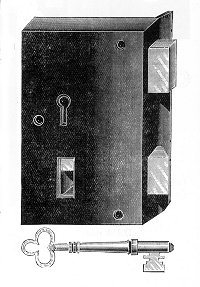

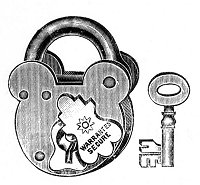
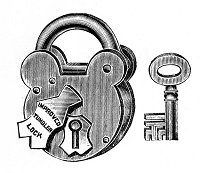
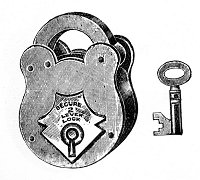
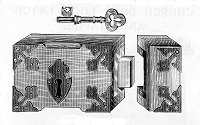

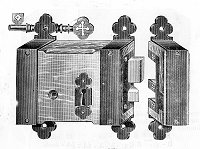
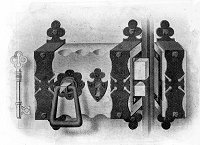
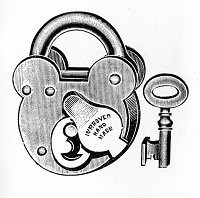

|
The later Tildesley takes us forward in time. He comments that
"originally locks were made by small master men in tiny shops at the
rear of their own homes. No machinery was used and as late as 1856 we are
told that even large manufacturers such as Messrs. Chubb of Wolverhampton
made their locks entirely by hand". But machinery was creeping in. In
1796 "Isaac Mason of Bilston came to reside in Willenhall and bought
new methods of pressing out lock parts which he had recently perfected.
The operation was carried out on a fly-press and meant the saving of much
labour and time". Then in 1812 John Grimley moved from Birmingham to
Willenhall and started to make keys using a drop forge. Nevertheless,
Tildesley says it was not until the first half of the 20th
century that machinery was extensively used – which, he points out,
meant that "the emphasis has passed from the locksmith to the
toolmaker, for with the perfectly designed and accurately made tools the
final operation of assembly has been so simplified that, in most cases, it
can be done by semi-skilled labour". He says that "one of the
earliest firms to use machinery was John Harper and Company of Albion
Works who, in 1856, installed a Nasmith steam hammer for forging
purposes".
We get another picture of the industry in the later nineteenth century
from the history of two productive co-operatives. These were associations
of individual workers who came together to form a co-operative in
accordance with the principles of co-operation that had lead to the
creation of so many retail co-operative shops. These productive
co-operatives do not seem to have been long lived or very successfully,
except where they sold their production to co-operative retailers. But
there were two such co-ops in the Wolverhampton lock industry, details of
which are given in Ned Williams’ The Co-op In Birmingham and the Black
Country (Uralia Press, 1993, at p.118).
In September 1877 the Co-operative News gave an account of "The
Wolverhampton and Breedwood Industrial and Provident Plate Lock
Manufacturing Society". It is interesting to note that lock making
was still sufficiently divided for the makers of plate locks ("of
iron, with mighty keys and intricate wards, burglar proof and admirable
for barn doors") to form their own co-operative; and that Brewood was
still sufficiently involved in the lock making industry to be included.
Ned Williams thinks that this Society may have come into existence in
1864, possibly as a result of a strike in the local plate lock industry.
He also records that they were fortunate to find a benefactor who provided
the first premises. Indeed, judging by the histories of other such
co-operatives support from the more moneyed classes was not that uncommon.
But the Co-operative News took a more confrontational approach in its
account:
"[S]even plate lock makers, holding between them just £13 in
money, formed a society and began business on their own account.
"The first result that followed was the combination of the
Wolverhampton firms in that line against them. The idea of fair play and
"live and let live" is not strong in the English manufacturer,
and for many months a bitter commercial quarrel raged between these
workmen and their late employers…. On one side a number of wealthy
firms, on the other a feeble little society of locksmiths, a handful of
men, striving to make the labour of their hands more fruitful. For many
weeks the society sold its goods at a loss, till at last the quality of
the locks became known, more of their fellows joined, and the ruinous
competition came to an end. The little shop on Stafford Street has now
grown to three, the little company of seven has increased to seventy
five, the society’s sales now reach £300 a week, while the capital
has grown from £13 to £16,000."
Despite all this the Society seems to have been wound up on 11th
August 1879. "A letter published in The Times explained that a lack
of orders and an excess of unsold stock caused its demise. The iron trades
went into a great depression at about that time, and therefore the
co-operative’s demise has to be seen in that context." It might
also be the case that, although individuals continued working on their own
well into the next century, the co-op’s position was not helped by the
increasing influence on the industry of highly capitalised mass producers.
A second attempt at co-operation, The Wolverhampton General Locksmiths’
Co-operative Society, started in 1890, was reported in 1892 as making
locks for the General Post Office, but had faded from the scene by 1895.
It was a natural result of the coming of machinery that larger firms,
mostly registered limited liability companies, with access to the
necessary capital, entered the industry, which they came to dominate,
largely, though not exclusively, until the middle of the 20th
century, excluding the individual or family locksmith.
It seems a natural extension of lock making and bolt making, to go on
to make general hardware. That is what some companies
did. But some companies moved the other way, starting as
producers of general ironware and then adding locks and bolts to their
range.
At some point the lock making industry added safe making to its
repertoire with, it seems, some existing companies simply moving into the
trade and others being set up for the express and more or less exclusive
purpose. It is interesting to note that the safe making industry entered
into the export trade, despite the difficulties which the weight of their
products must have caused.
Once you are into making locks and safes, it is natural to diversify
into other security devices and systems and some bigger companies started
on such things as strong rooms, safe deposit systems and the like. Thus in
the Wolverhampton Official Year Book for 1953 Chubbs are described as:
"Bankers’ engineers, manufacturers of bankers’ anti-blowpipe
safes and doors, strong rooms and linings, burglar and fire-resisting
safes and strong room doors, steel grilles and gates, safe deposits,
certified safe cabinets, safe files, ledger containers, wall safes, cash
and deed boxes and all types of locks."
The first half of the twentieth century saw the disappearance of the
back yard lock maker, who was unable to compete with the larger firms and
whose poor competitive position was made worse by factory and employment
legislation which required a capital investment the small man could not
make. Soon a few firms dominated the industry and, in the second half of
the twentieth century, they also felt the chill winds of competition.
There were closures, takeovers and amalgamations until, at the beginning
of the twenty-first century, there is but a small number of firms
continuing in the trade, including one large company resulting from the
merger of some of the biggest of the old companies; and that is in foreign
ownership.
|














